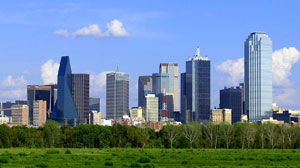What's behind urban heat islands?
Atmospheric turbulence keeps the countryside cooler than urban areas on summer days
Jan 13, 2015 - by Staff
Jan 13, 2015 - by Staff
January 13, 2015 | When a team of researchers wanted new insights into why cities tend to be much warmer than surrounding areas, they turned to a specialized and increasingly powerful piece of software that simulates urban environments.
The software, part of the NCAR-based Community Earth System Model, focuses on how cities and their residents will be affected by heat waves and other aspects of climate change. The latest version simulates both dense downtowns and more residential areas, as well as atmospheric conditions such as humidity and wind that affect human health during heat waves.

New research shows that the comparatively smooth surfaces of buildings, such as these in Dallas, contribute to the urban heat island effect. (Photo by drumguy8800 via Wikipedia Commons.)
“More than half the world’s population lives in cities, so it’s important to simulate that environment,” said NCAR scientist Keith Oleson, who works on the urban simulations. “We want to project how climate is likely to change in different types of cities and how that may affect their residents.”
Oleson was a co-author on a recent study in Nature, led by Lei Zhao at Yale University and China’s Nanjing University of Information Science and Technology, that quantified the primary reasons that urban areas are generally warmer than surrounding countryside. This phenomenon is known as the urban heat island effect.
When moisture evaporates from trees and crops, it helps cool the air slightly. Because of this, scientists have long believed that the main cause of urban heat islands is the lack of evaporation from vegetation-sparse cities. Using the urban model as well as satellite observations, the authors reaffirmed this understanding for nighttime temperatures.
However, it's a different story by daylight, as the researchers found that other factors are responsible for keeping cities hotter than rural areas. Those factors differ between dry and moist areas, according to the study, which analyzed 65 cities across North America.
In more humid regions, the authors found that a lack of atmospheric turbulence plays a key role in keeping some cities hotter than their surroundings. The smooth surfaces of buildings and other structures are less conducive to removing heat from the surrounding air because they do not trigger as much vertical movement in the atmosphere as do the rougher surfaces of the lush vegetation surrounding these humid cities.
The study found that a different process predominated in drier cities, such as those in the U.S. Southwest. In those settings, where surrounding vegetation is shorter and more sparse, rural areas are less effective at dissipating heat.
Such results can help urban planners modify urban landscapes in ways that minimize heat stress for residents. For example, while it may not be easy to create more surface roughness to dissipate heat, the study reaffirmed a much-discussed strategy of constructing parking lots, roads, and buildings with lighter colors so they better reflect heat back into space.
The next version of the urban climate model will provide even more information for policy makers. It will simulate the extent to which heating and air conditioning systems in buildings affect ambient temperatures. This is an increasingly important issue for megacities in developing countries such as India, where air conditioning units are becoming more common.
“This 'waste heat' might exacerbate the urban heat island effect, because you’re essentially moving heat from the inside of a building to the outside,” Oleson said. Other researchers have found that waste heat from cities may be enough to influence temperatures thousands of miles away.
Writer/contact
David Hosansky, NCAR|UCAR Communications